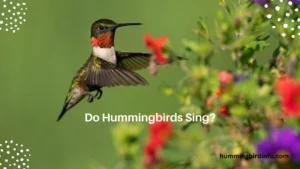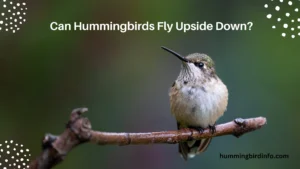The hummingbird is often admired for its dazzling colors and lightning-fast movements, but amid this visual spectacle lies a fascinating mystery — their chirps. These tiny creatures break the silence with sharp, high-pitched sounds that invite the question: what are they communicating?
These brief vocalizations carry big messages.
Understanding why hummingbirds chirp unlocks a secret world of communication essential to their survival. From marking territories to attracting mates and signaling danger, their chirps reveal a complex language packed into tiny bursts of sound.
This makes hummingbird vocalizations not only intriguing but crucial to understanding their behavior.
In this article, we’ll explore the many reasons hummingbirds chirp, the different types of sounds they produce, and how these sounds compare to other birds.
You’ll discover how these tiny voices play a big role in the hummingbird’s fast-paced life, and why listening closely can change how you see these incredible birds.
Contents
- 0.1 The Basic “Chip”: Contact and Presence
- 0.2 Territorial Declarations: “Get Off My Flowers!”
- 0.3 The Language of Love: Courtship Chirps and Songs
- 0.4 Alarms and Warnings: “Danger Nearby!”
- 0.5 The Mechanics of the Chirp: How They Make the Sound
- 0.6 Comparisons with Other Bird Vocalizations
- 0.7 Learning and Development of Vocalizations
- 1 Conclusion
- 2 FAQs
The Basic “Chip”: Contact and Presence
The most common hummingbird sound is a short, high-pitched chip or tsip, used to maintain contact with other birds. This simple call often happens during routine activities like feeding or flying between flowers, helping them stay aware of neighbors.

These contact calls may also carry subtle differences that allow birds to recognize individuals, though this is still being studied. Young hummingbirds use similar chirps to communicate with their mothers, signaling their location or needs.
This basic vocalization helps hummingbirds navigate their social environment, balancing awareness and independence in their busy, nectar-fueled world.
Territorial Declarations: “Get Off My Flowers!”
When a hummingbird feels its territory threatened, the simple chip escalates into a rapid series of sharp, loud chirps that warn intruders. These vocal warnings often accompany aerial chases, making clear the bird’s determination to defend its feeding area.
Territorial calls vary by species and individual, sometimes sounding harsher or more insistent depending on the situation. At feeders, especially, hummingbirds fiercely guard their nectar sources using these vocal battles to keep rivals at bay.
Males are typically the most vocally aggressive, particularly during breeding season, using chirps as a loud “stay away” sign to protect their turf and increase mating success.
The Language of Love: Courtship Chirps and Songs
Male hummingbirds add complexity to their chirps during courtship, using a mix of chirps, buzzes, and soft warbles to attract females. These courtship songs vary between species and can be surprisingly intricate despite lacking the melodious quality of some songbirds.
Often, males perch in visible spots and sing to advertise their presence, combining vocal displays with stunning aerial dives and swoops. These performances showcase their fitness and charm potential mates.
Females respond too, sometimes with soft chirps, forming a subtle dialogue in the delicate dance of hummingbird romance.
Alarms and Warnings: “Danger Nearby!”
Hummingbirds emit sharp, urgent chirps when sensing danger, such as predators like cats or hawks nearby. These alarm calls alert other hummingbirds, sometimes rallying them into a mob to harass and drive away threats.
Injured or distressed birds also produce unique vocalizations, signaling their vulnerability. The meaning of a chirp can only be understood by considering the context—whether it’s an aggressive defense, a mating call, or an urgent warning.
This complex use of sound reflects the hummingbird’s need for constant vigilance in a world full of dangers.
The Mechanics of the Chirp: How They Make the Sound
Unlike mammals, hummingbirds produce sounds using a specialized organ called the syrinx, located where the windpipe splits. Rapid muscle movements around the syrinx enable them to produce the distinctive high-pitched chirps.
Their famous humming noise comes from wingbeats, not vocal cords, but these wing sounds sometimes mix with vocalizations during displays. Although their vocal range is more limited than many songbirds, hummingbirds efficiently use their chirps to communicate vital information.
This unique sound production highlights how hummingbirds’ anatomy supports their fast, intricate lives.
Comparisons with Other Bird Vocalizations
Compared to the elaborate songs of many songbirds, hummingbird vocalizations are simpler but higher in frequency. This high pitch suits their small size and dense habitats, making their calls less likely to travel far but very effective at close range.
The energetic cost of singing is high for any bird, and hummingbirds balance their need to vocalize with their intense energy demands from rapid flight and feeding. Their brief, sharp chirps reflect this balance between communication and conservation of energy.
Thus, hummingbirds’ vocal strategy is adapted perfectly to their unique lifestyle.

Learning and Development of Vocalizations
Some hummingbird calls seem to be innate, meaning they are born with the ability to produce them. However, there might be some learning involved as young birds mature, adjusting calls based on their environment or social interactions.
Juveniles start with basic chirps and refine their vocalizations as they grow, which helps them integrate into hummingbird society and eventually establish their own territories and mating opportunities.
This blend of instinct and experience shapes their vocal language.
Conclusion
Hummingbird chirps are a rich, varied language that plays a crucial role in their survival. From simple contact calls to fierce territorial warnings, elegant courtship songs, and urgent alarms, these tiny birds use sound to navigate a fast-paced and competitive world.
Understanding their chirps offers a glimpse into their social lives, behaviors, and challenges. It reminds us that even the smallest creatures have complex ways of communicating needs and emotions.
By tuning in to these tiny voices, we gain a deeper appreciation for the hummingbird’s remarkable world and the powerful messages packed into their brief, brilliant chirps.
FAQs
1. Why do hummingbirds chirp so often?
Hummingbirds chirp frequently to communicate their presence, defend territory, attract mates, and warn of danger.
2. Are hummingbird chirps different between species?
Yes, species often have unique chirps and songs that help with identification and mating.
3. Do female hummingbirds chirp?
Females do chirp, but generally less than males, mostly for communication and response during courtship.
4. Can hummingbirds recognize each other by chirps?
It’s possible; subtle variations may allow individual recognition, though more research is needed.
5. How loud are hummingbird chirps?
They are generally soft but sharp, suited for close-range communication.
6. Do hummingbirds learn their chirps or are they innate?
Some calls are innate, but juveniles may learn and refine their vocalizations over time.








